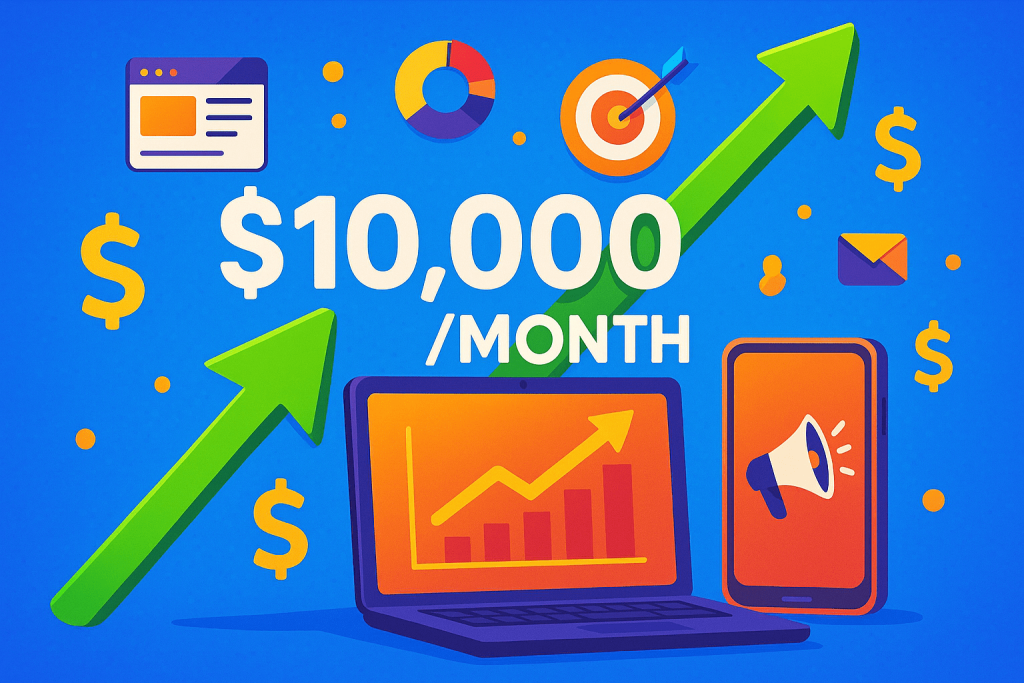$10,000 Month Online Business is achievable with the right step-by-step blueprint. Moreover, by selecting a profitable niche, validating your idea, and scaling through content, traffic, and monetization strategies, you can build an online business from scratch that consistently generates five-figure monthly revenue.
This comprehensive guide will walk you through every step of building a sustainable online business, from initial niche selection to scaling beyond five figures monthly. Ultimately, by following this proven blueprint and maintaining consistent effort over 9–12 months, you can create multiple income streams that generate $10,000 or more each month. Moreover, these strategies compound over time to accelerate your growth.
Strategic Niche Selection: Finding Your Profitable Market
The foundation of any successful online business lies in choosing the right niche—one that balances your expertise, market demand, and profit potential. Unlike general business advice that suggests following your passion blindly, data-driven niche selection requires rigorous research. For example, instead of relying on gut feelings, analyze keyword demand and competition; therefore, you identify markets with real profit potential.

Market Research Framework:
Start by identifying niches with proven demand but manageable competition. Use keyword research tools to find topics with 10,000-50,000 monthly searches and medium difficulty scores. The sweet spot lies in markets where people actively spend money and have recurring problems that need solving.
Profitability Indicators:
Look for niches where customers already spend money. Check Amazon’s bestseller lists, Udemy’s top courses, and affiliate programs with high commissions. A profitable niche typically has:
- Products selling for $50-500+ regularly
- Active affiliate programs offering 20-50% commissions
- Subscription-based services indicating recurring revenue potential
- High-value problems that people pay to solve
Competition Analysis:
Study successful competitors to understand market dynamics. Identify content gaps, underserved segments, and opportunities for differentiation. The goal isn’t to avoid competition entirely but to find angles where you can provide unique value.
Validation Techniques:
Before committing resources, validate your niche choice through:
- Social media group analysis to understand pain points
- Google Trends research for growth trajectory
- Direct competitor analysis of their content performance
- Survey potential customers about their biggest challenges
Popular High-Value Niches for 2025:
Based on current market trends, profitable niches include:
- Health and wellness coaching
- Digital marketing and business education
- Personal finance and investing
- Sustainable living and eco-products
- Remote work productivity tools
- Pet care and training
- Home organization and lifestyle
The key is finding a niche that intersects your knowledge, market demand, and profit potential. This intersection becomes your competitive advantage and the foundation for sustainable growth.
Market Validation: Proving Your Business Concept
Before investing months building a business, smart entrepreneurs validate their concepts with real market feedback. Consequently, this step separates successful businesses from costly failures, and ensures you’re solving problems people will actually pay to solve. Moreover, gathering early feedback helps refine your offerings before significant time and resources are committed.
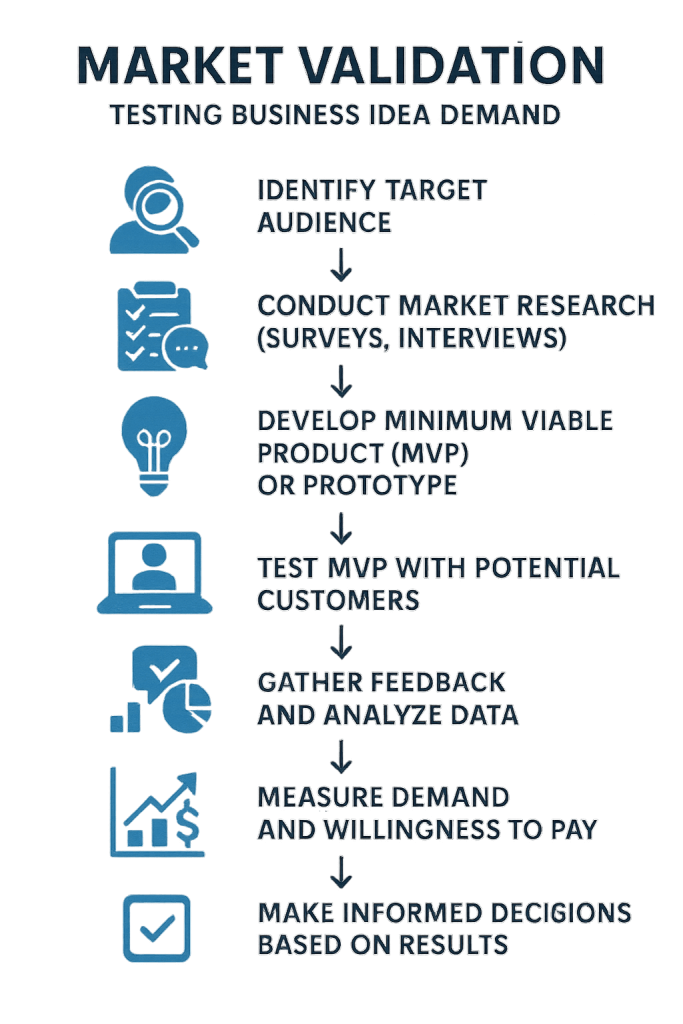
Pre-Launch Validation Methods:
The most effective validation happens before you create any products. Start by testing market response through minimal viable approaches:
Create simple lead magnets—free guides, checklists, or mini-courses—that address your target audience’s core problems. Run targeted Facebook or Google ads to these lead magnets with budgets of $50-100. If you can’t generate leads at $2-5 per lead, your niche may need refinement.
Direct Customer Research:
Survey potential customers using tools like Type form or Google Forms. Ask specific questions about their biggest challenges, current solutions, and willingness to pay for better alternatives. Aim for 50-100 responses to identify patterns and validate demand.
Pre-Selling Strategy:
One of the strongest validation signals is customers willing to pay before you’ve created the final product. Launch a pre-order campaign or presell a course/service at a discount. If you can generate 10-20 pre-orders, you’ve proven market demand exists.
MVP Testing:
Create a minimum viable product (MVP) version of your solution. This could be a basic version of your service, a pilot course, or a simple digital product. Test this with a small group of customers and gather detailed feedback about their experience and results.
Social Proof Collection:
Document your validation process and early results. Customer testimonials, survey responses, and pre-order confirmations become powerful social proof for your full launch. This early validation content also forms the foundation of your marketing materials.
Iteration Based on Feedback:
Use validation feedback to refine your approach. For instance, customers may want different features, pricing models, or delivery methods than you initially planned; therefore, this early course correction saves months of building something the market doesn’t want. Typically, the validation phase takes 4–8 weeks, but it prevents the costly mistake of building a business without proven demand. Consequently, companies that skip validation face significantly higher failure rates and wasted resources.
Building Your Professional Online Platform
Your website serves as the central hub for your online business—it’s where visitors become leads, leads become customers, and customers become repeat buyers. In 2025, having a professional, fast-loading, mobile-optimized platform is non-negotiable for reaching $10,000 monthly revenue.
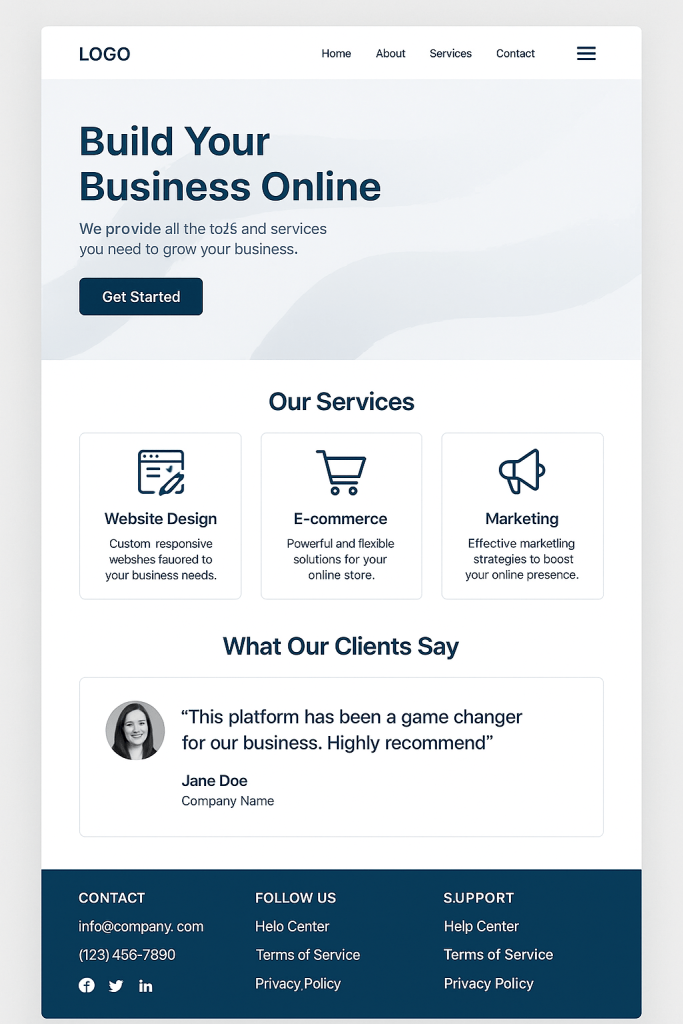
Platform Selection Strategy:
Choose a platform that balances ease of use with scalability. WordPress powers 43% of all websites and offers maximum flexibility, while platforms like Shopify excel for e-commerce. Consider your technical skills, budget, and growth plans when selecting your foundation.
Essential Technical Setup:
Start with these non-negotiable elements:
- SSL certificate for security (required for Google rankings)
- Mobile-responsive design (60%+ of traffic comes from mobile)
- Page loading speeds under 3 seconds
- Clean URL structure that includes your target keywords
- XML sitemap for search engine crawling
SEO-Optimized Architecture:
Structure your site to support both user experience and search engine optimization. Create clear navigation that helps visitors find information quickly while organizing content in logical hierarchies that search engines can understand.
Conversion-Focused Design:
Every page should guide visitors toward specific actions—joining your email list, scheduling consultations, or making purchases. Use clear calls-to-action, social proof elements, and value propositions that communicate benefits immediately.
Performance Optimization:
Website speed directly impacts both user experience and search rankings. Optimize images, enable caching, use content delivery networks (CDNs), and choose reliable hosting that can handle traffic spikes as your business grows.
Analytics and Tracking Setup:
Install Google Analytics, Google Search Console, and conversion tracking from day one. These tools provide crucial data about visitor behavior, traffic sources, and conversion rates that inform optimization decisions.
Content Management System:
Set up your site structure to accommodate the content marketing strategy you’ll implement. Create templates for blog posts, landing pages, and product pages that maintain consistency while allowing for customization.
Legal and Trust Elements:
Include privacy policies, terms of service, and about pages that build credibility. Display security badges, testimonials, and contact information prominently to establish trust with potential customers.
The initial platform setup typically takes 2-4 weeks but creates the foundation for all future growth. Investing in a professional setup from the beginning prevents costly redesigns and technical issues later.
Content Creation That Converts
Content marketing remains one of the most effective strategies for building authority, attracting organic traffic, and nurturing prospects into customers. High-quality content can drive 3x more leads than paid advertising while costing 62% less, making it essential for reaching $10,000 monthly revenue.
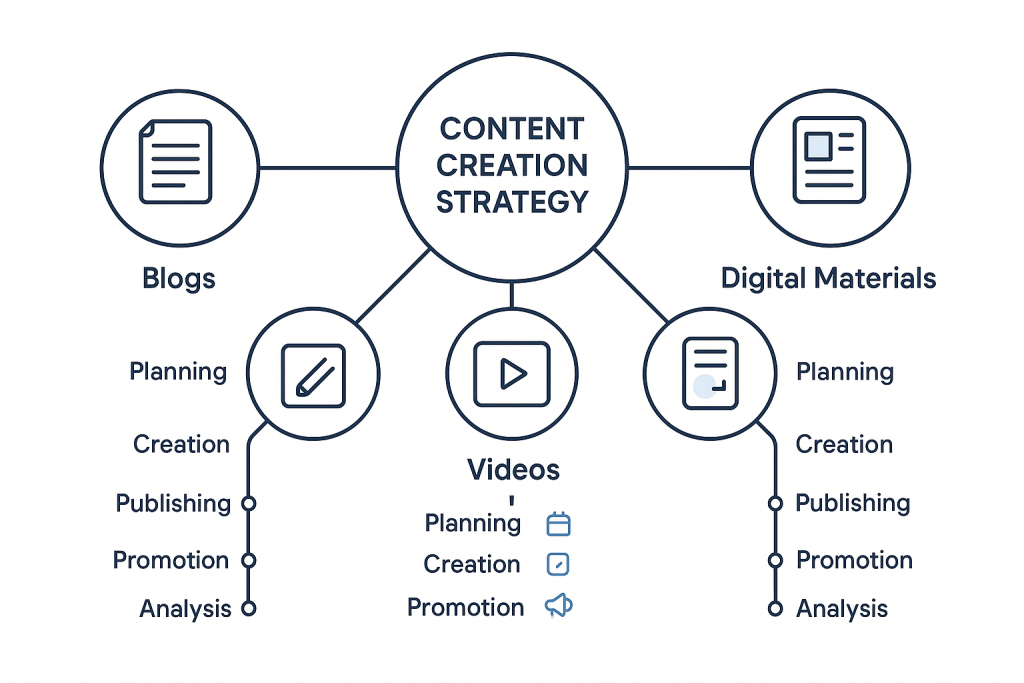
Strategic Content Planning:
Develop content around your audience’s buying journey—awareness, consideration, and decision stages. Create awareness content that attracts new visitors, consideration content that nurtures interest, and decision content that converts prospects into customers.
High-Value Content Formats:
Focus on content types that provide substantial value and rank well in search engines:
- Comprehensive guides (3,000+ words) targeting high-value keywords
- Step-by-step tutorials that solve specific problems
- Case studies showcasing real results and transformations
- Comparison articles helping buyers make informed decisions
- Tools and resources that provide immediate utility
SEO Content Optimization:
Every piece of content should target specific keywords while providing genuine value. Use keyword research tools to identify terms your audience searches for, then create content that answers their questions comprehensively.
Content Distribution Strategy:
Create once, distribute everywhere. Repurpose your pillar content into:
- Social media posts for different platforms
- Email newsletter segments
- Podcast episodes or video content
- Infographics and visual summaries
- Guest post opportunities on relevant sites
Authority Building Through Expertise:
Position yourself as an expert by sharing specific insights, behind-the-scenes processes, and lessons learned. Personal experiences and unique perspectives differentiate your content from generic information available elsewhere.
Community Engagement:
Respond to comments, engage in relevant online communities, and participate in industry discussions. This builds relationships and drives traffic back to your content while establishing your reputation as a helpful expert.
Content Calendar and Consistency:
Maintain a consistent publishing schedule that your audience can depend on. Whether it’s weekly blog posts, daily social media updates, or monthly in-depth guides, consistency builds audience expectations and search engine favor.
Performance Measurement:
Track content performance through metrics like organic traffic growth, time on page, social shares, and conversion rates. Use this data to identify your most effective content types and topics for future planning.
Quality content creation is a long-term investment that compounds over time. Content published today can continue driving traffic and conversions for years, making it one of the highest-ROI activities for online businesses.
Traffic Generation: Building Your Audience
Sustainable $10,000 monthly revenue requires consistent traffic from multiple sources. While paid advertising can provide quick results, organic traffic through SEO and content marketing offers the best long-term return on investment.
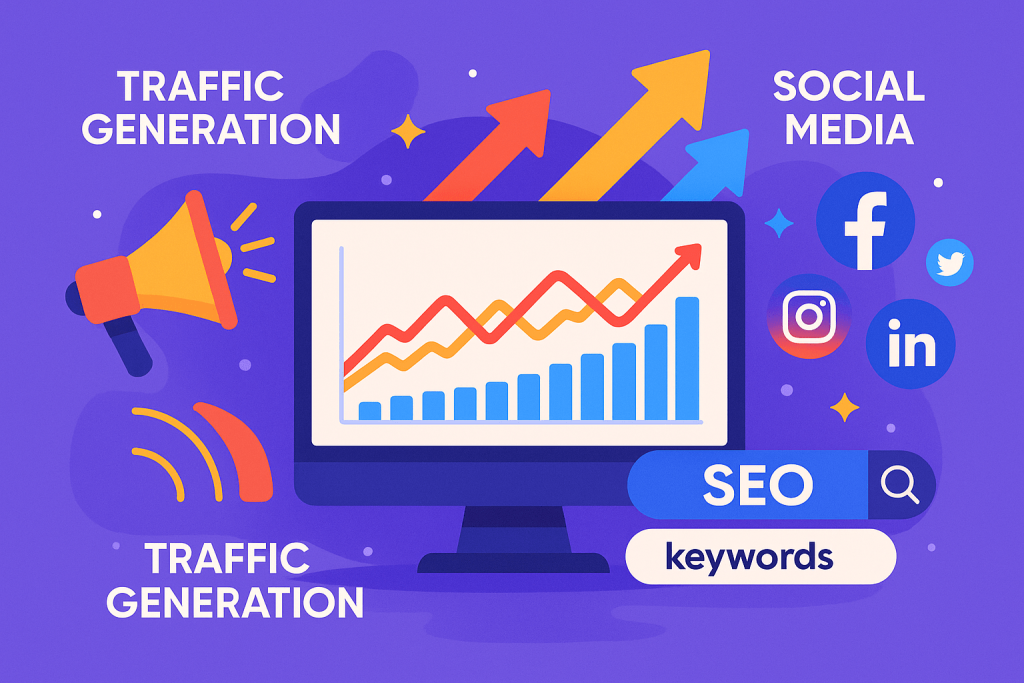
Search Engine Optimization (SEO):
SEO remains the most cost-effective long-term traffic strategy. Focus on:
- Keyword Research: Target long-tail keywords with commercial intent
- On-Page Optimization: Optimize titles, meta descriptions, and content structure
- Technical SEO: Ensure fast loading speeds and mobile-friendliness
- Link Building: Earn high-quality backlinks from relevant websites
- Local SEO: If applicable, optimize for local search queries
Studies show that businesses using SEO strategies see revenue growth rates up to 2.8 times higher than those without.
Content Marketing Integration:
Your content strategy and traffic generation work together synergistically:
- Create cornerstone content targeting high-volume keywords
- Develop topic clusters around main themes in your niche
- Guest post on relevant blogs with backlinks to your content
- Participate in podcasts and interviews as an expert
- Share valuable insights in online communities and forums
Social Media Strategy:
Choose 2-3 platforms where your audience is most active rather than trying to be everywhere:
- LinkedIn: Excellent for B2B and professional services
- Instagram: Visual content and lifestyle-focused businesses
- YouTube: Tutorial and educational content performs well
- TikTok: Short-form, entertaining content for younger demographics
- Pinterest: Great for visual and DIY-focused niches
Email Marketing Foundation:
Build your email list from day one—it’s your most valuable traffic asset:
- Create compelling lead magnets that solve specific problems
- Set up automated welcome sequences for new subscribers
- Send regular newsletters with valuable content and offers
- Segment your list based on interests and behaviors
- Test subject lines and sending times for optimal engagement
Paid Advertising (When Ready):
Once you have proven conversion processes, strategic paid advertising can accelerate growth:
- Start with small budgets ($10-20/day) to test ad performance
- Focus on retargeting website visitors before cold audiences
- Use lookalike audiences based on your best customers
- Test different ad formats and messaging
- Track return on ad spend (ROAS) carefully
Influencer and Partnership Marketing:
Collaborate with others in your niche to expand reach:
- Partner with micro-influencers (1,000-100,000 followers)
- Create joint ventures with complementary businesses
- Participate in online summits and collaborative content
- Cross-promote with other content creators
- Speak at virtual events and webinars
Traffic Diversification:
Never rely on a single traffic source. Aim for a mix that includes:
- 40-50% organic search traffic
- 20-30% direct traffic (brand searches and returning visitors)
- 15-25% social media traffic
- 10-15% email marketing traffic
- 5-10% paid advertising (when profitable)
Building substantial traffic takes time—typically 6-12 months for organic strategies to gain momentum. However, the compound effect of consistent effort creates sustainable audience growth that supports $10,000+ monthly revenue.
Monetization Mastery: Multiple Revenue Streams
Reaching $10,000 monthly requires diversified income streams that complement each other while serving your audience’s varying needs and budgets. The most successful online businesses combine multiple monetization methods rather than relying on a single revenue source

Digital Product Sales:
Digital products offer the highest profit margins—often 90-95%—since there are no inventory or shipping costs:
Online Courses: Package your expertise into structured learning experiences. Successful courses typically sell for $97-997+ and can generate substantial passive income once created. Focus on specific outcomes and transformations rather than general education.
E-books and Guides: Create in-depth resources that solve specific problems. While individual e-books may sell for $19-97, they serve as excellent lead generation tools and can be bundled with higher-value offers.
Templates and Tools: Develop practical resources your audience uses regularly—planning templates, design assets, or software tools. These often have high perceived value and encourage repeat purchases.
Affiliate Marketing Revenue:
Promote products and services you genuinely use and recommend. Successful affiliate marketing requires:
- Choosing products aligned with your audience’s needs
- Disclosing affiliate relationships transparently
- Creating honest reviews and comparisons
- Building trust before promoting anything
- Tracking performance to optimize promotions
Top affiliate marketers focus on high-value products ($100-1000+ commission per sale) rather than low-ticket items, making it easier to reach $10,000 monthly targets.
Service-Based Offerings:
High-value services can quickly generate substantial revenue:
- Consulting/Coaching: One-on-one sessions typically range from $100-500+ per hour
- Done-for-You Services: Complete solutions for businesses often command $1,000-10,000+ per project
- Group Programs: Combine the personal touch of coaching with scalable group delivery
Subscription and Membership Models:
Recurring revenue creates predictable income streams:
- Membership Communities: Exclusive access to content, community, and resources
- Software as a Service (SaaS): Tools that solve ongoing problems
- Subscription Boxes: Curated products delivered regularly
- Premium Content: Advanced tutorials, industry insights, or exclusive resources
Physical Product Sales:
If applicable to your niche, physical products can complement digital offerings:
- Print-on-Demand: T-shirts, mugs, and custom products with no inventory risk
- Private Label Products: Source and brand existing products
- Handmade Items: Unique products that command premium prices
Speaking and Workshop Revenue:
As your authority grows, speaking opportunities emerge:
- Virtual Workshops: Interactive sessions teaching specific skills
- Corporate Training: B2B companies pay well for relevant training
- Conference Speaking: Often includes speaking fees plus exposure
- Mastermind Facilitation: High-value group experiences
Revenue Stream Progression:
Most successful businesses follow this monetization timeline:
- Months 1-3: Focus on one primary revenue stream (often services or affiliate marketing)
- Months 4-6: Add complementary income sources
- Months 7-12: Optimize and scale successful streams while testing new ones
- Year 2+: Develop passive income sources and higher-value offerings
The key is starting with one monetization method, proving it works, then systematically adding others. This approach prevents overwhelm while building sustainable revenue growth toward $10,000+ monthly.
Email Marketing: Your Revenue Engine
Email marketing consistently delivers the highest ROI of any digital marketing channel—averaging $42 return for every $1 spent.
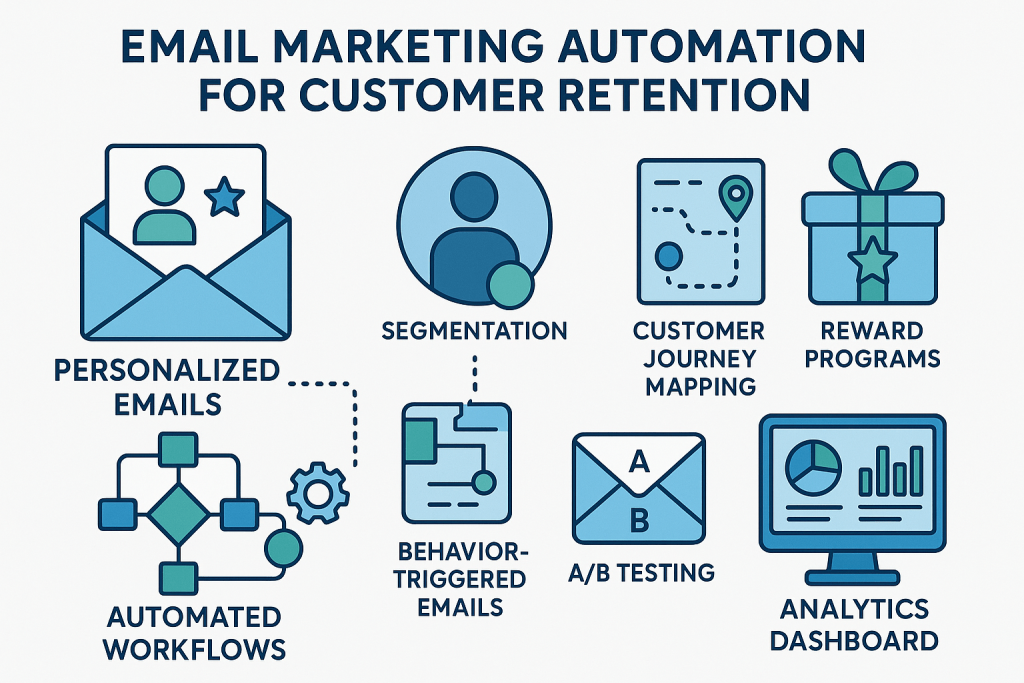
For online businesses targeting $10,000 monthly revenue, a well-executed email strategy often becomes the primary conversion driver.
List Building Fundamentals:
Your email list is your most valuable business asset because you own direct access to your audience. Build your list through:
High-Value Lead Magnets: Create irresistible free resources that solve immediate problems. The best lead magnets are specific, actionable, and provide quick wins. Examples include checklists, templates, mini-courses, or exclusive reports.
Strategic Opt-in Placement: Position email capture forms where they’ll get maximum visibility—website headers, blog post endings, social media profiles, and as content upgrades within relevant articles.
Content Upgrades: Offer bonus materials related to specific blog posts or videos. When someone reads about “10 SEO Tips,” offer a downloadable “SEO Checklist” to capture their email.
Segmentation Strategy:
Not all subscribers are equal. Segment your lists based on:
- Interests: Different product categories or topics
- Behavior: Engagement levels and purchase history
- Demographics: Location, business size, or experience level
- Customer Journey Stage: New subscribers vs. loyal customers
Segmented campaigns can increase revenue by up to 760% compared to broadcast emails.
Automated Email Sequences:
Set up systems that nurture subscribers automatically:
Welcome Series: Introduce new subscribers to your brand, provide promised lead magnets, and set expectations for future communications. A 5-7 email welcome sequence typically performs better than single welcome emails.
Educational Sequences: Teach valuable concepts over time while positioning your expertise. These sequences build trust and authority before making any sales offers.
Sales Sequences: Promote products or services through strategic email campaigns that address objections, provide social proof, and create urgency appropriately.
Re-engagement Campaigns: Win back inactive subscribers with special offers or content designed to reignite their interest.
Revenue-Generating Email Types:
Newsletter Content: Regular value-driven emails that keep your audience engaged between promotional campaigns. Share insights, tips, case studies, and industry news relevant to your niche.
Product Launches: Coordinate email campaigns with new product releases, using anticipation-building sequences that culminate in sales-focused messages.
Promotional Campaigns: Strategic sales emails for existing products, seasonal offers, or partner promotions. Balance promotional content with value-driven emails to maintain subscriber engagement.
Personal Stories: Share behind-the-scenes content, lessons learned, and personal experiences that build deeper connections with your audience.
Performance Optimization:
Track key metrics to continuously improve performance:
- Open Rates: Test subject lines and sending times
- Click-Through Rates: Optimize email content and calls-to-action
- Conversion Rates: Improve landing pages and offers
- List Growth: Monitor subscription rates and lead magnet performance
- Revenue Per Email: Calculate the direct financial impact of campaigns
Email Marketing Timeline:
Most successful email strategies follow this progression:
- Month 1: Set up basic email system and create initial lead magnet
- Months 2-3: Develop welcome sequence and begin regular newsletters
- Months 4-6: Add segmentation and automated nurture sequences
- Months 7-12: Optimize performance and develop advanced campaigns
A well-managed email list of 1,000-5,000 engaged subscribers can generate $1,000-5,000+ monthly revenue, making it a crucial component of any $10,000/month business strategy.
Scaling and Automation Systems
Reaching $10,000 monthly revenue requires systems that work without your constant involvement. The most successful online businesses automate repetitive tasks while focusing human energy on high-value activities that drive growth

Business Process Automation:
Identify and automate time-consuming tasks that don’t require personal attention:
Customer Service: Implement chatbots for common questions, create comprehensive FAQ sections, and use helpdesk software to manage support tickets efficiently. This can reduce support time by 50-70% while improving response times.
Content Distribution: Use tools like Buffer or Hootsuite to schedule social media posts across multiple platforms. Create content once and distribute it automatically according to optimal posting schedules.
Lead Nurturing: Set up automated email sequences that guide prospects through your sales funnel without manual intervention. This can increase conversion rates by 50%+ compared to manual follow-up.
Financial Management: Automate invoicing, payment processing, and basic bookkeeping tasks. Tools like QuickBooks or FreshBooks can handle routine financial operations automatically.
Delegation and Outsourcing:
Smart delegation frees up your time for high-impact activities:
Content Creation: Hire freelance writers, video editors, or graphic designers to handle content production. This allows you to focus on strategy while maintaining consistent output.
Virtual Assistants: Delegate administrative tasks, email management, and routine customer service to skilled VAs. This typically costs $5-15 per hour versus your time value of $50-200+ per hour.
Specialized Services: Outsource technical tasks like website maintenance, SEO, or paid advertising management to experts who can achieve better results faster.
Systems and Processes Documentation:
Create standard operating procedures (SOPs) for all business activities:
- Document step-by-step processes for recurring tasks
- Create training materials for team members
- Establish quality control checkpoints
- Build templates for common activities
Well-documented systems allow for easier delegation and ensure consistency as you scale.
Technology Stack Optimization:
Choose tools that integrate well and grow with your business:
Customer Relationship Management (CRM): Track leads, customers, and sales activities in one central system. Options like HubSpot or Pipedrive can automate much of your sales process.
Marketing Automation: Platforms like ActiveCampaign or ConvertKit can handle email marketing, lead scoring, and behavioral triggers automatically.
Analytics and Reporting: Set up dashboards that automatically track key performance indicators (KPIs) so you can make data-driven decisions quickly.
Project Management: Use tools like Asana or Monday.com to coordinate team activities and track project progress automatically.
Revenue Stream Automation:
Focus on monetization methods that generate income with minimal ongoing effort:
Digital Product Sales: Once created, digital products can sell automatically through your website with payment processing, delivery, and customer onboarding handled by systems.
Affiliate Marketing: Automated email sequences and evergreen content can promote affiliate products continuously without daily management.
Subscription Services: Recurring billing systems handle payments and access management automatically, creating predictable monthly revenue.
Online Courses: Self-serve course platforms allow students to enroll, access content, and complete programs without instructor involvement.
Scaling Timeline:
Most businesses follow this automation progression:
- Months 1-6: Focus on revenue generation and manual processes
- Months 7-12: Automate repetitive tasks and begin delegation
- Year 2: Implement advanced systems and build team capabilities
- Year 3+: Achieve largely automated operations with strategic oversight
Ultimately, the goal is creating a business that generates $10,000+ monthly while requiring only 20–30 hours of your personal time per week. Furthermore, this combination of automation and smart delegation creates both financial freedom and lifestyle flexibility.
Financial Management and Metrics
Achieving sustainable $10,000 monthly revenue requires careful financial management and data-driven decision making. Understanding your numbers allows you to identify profitable activities, eliminate waste, and scale what’s working effectively.
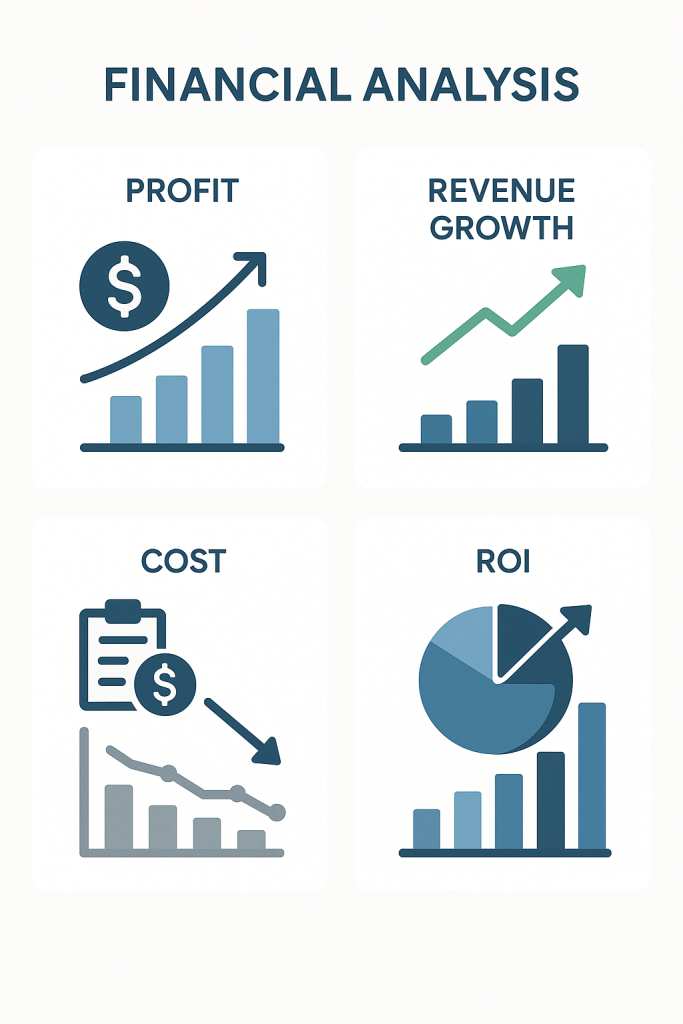
Revenue Tracking and Analysis:
Monitor income streams individually to understand which activities generate the most profit:
Revenue by Source: Track earnings from each monetization method—affiliate marketing, product sales, services, etc. This data reveals your most profitable activities and opportunities for expansion.
Customer Lifetime Value (CLV): Calculate how much the average customer spends over their entire relationship with your business. Higher CLV customers justify higher acquisition costs and targeted retention efforts.
Monthly Recurring Revenue (MRR): For subscription-based income streams, track predictable monthly revenue separately from one-time sales. MRR provides financial stability and easier growth planning.
Seasonal Patterns: Identify revenue fluctuations throughout the year to plan cash flow and marketing activities accordingly.
Expense Management:
Control costs while investing in growth activities:
Fixed vs. Variable Costs: Separate consistent monthly expenses (hosting, software subscriptions) from variable costs (advertising, contractors). This distinction helps with budgeting and scaling decisions.
Cost Per Acquisition (CPA): Track how much you spend to acquire each new customer through different channels. Ensure your CPA remains significantly below your CLV for sustainable profitability.
Return on Investment (ROI): Measure returns from major investments like advertising campaigns, course creation, or tool purchases. Focus resources on activities with the highest ROI.
Profit Margin Analysis: Calculate gross and net profit margins for different offerings. Higher-margin products and services should receive priority in your marketing efforts.
Key Performance Indicators (KPIs):
Track metrics that directly impact revenue growth:
Conversion Rates: Monitor how effectively you convert visitors to leads, leads to customers, and customers to repeat buyers. Small improvements in conversion rates can dramatically impact revenue.
Moreover, measure not just traffic volume but engagement metrics like time on site, pages per session, and bounce rates. After all, quality traffic converts better than high-volume, low-intent visitors.
Email List Metrics: Track list growth rate, open rates, click-through rates, and revenue per subscriber. Your email list often becomes your most valuable business asset.
Customer Acquisition Metrics: Monitor the cost and effectiveness of different marketing channels to optimize your customer acquisition strategy.
Cash Flow Management:
Maintain healthy cash flow to support growth:
Emergency Fund: Keep 3-6 months of expenses in reserve to handle income fluctuations or unexpected opportunities.
Reinvestment Strategy: Allocate 20-30% of monthly profit toward growth activities like advertising, content creation, or business development.
Tax Planning: Set aside 25-30% of revenue for taxes, especially if you’re operating as a sole proprietor or LLC. Consider quarterly estimated tax payments to avoid year-end surprises.
Separate Business Accounts: Keep business and personal finances completely separate for cleaner bookkeeping and easier tax preparation.
Financial Planning Tools:
Use technology to streamline financial management:
Accounting Software: QuickBooks, FreshBooks, or Wave can automate bookkeeping tasks and provide financial reporting.
Analytics Platforms: Google Analytics, social media insights, and email marketing analytics provide data for decision-making.
Dashboard Creation: Build executive dashboards that display key metrics at a glance, allowing for quick performance assessment.
Forecasting Models: Create simple spreadsheets that project future revenue based on current trends and planned activities.
Monthly Financial Review Process:
Establish a consistent review routine:
- Calculate total revenue by source and compare to previous months
- Review expenses and identify any unusual or unnecessary costs
- Analyze key metrics and identify trends or areas for improvement
- Plan next month’s budget including growth investments
- Update financial forecasts based on current performance
Regular financial analysis typically reveals opportunities to increase revenue by 15-25% through better resource allocation and optimization of profitable activities.
Timeline and Milestones for Success
Building a $10,000/month online business follows a predictable timeline when you execute consistently and make data-driven adjustments. Understanding realistic milestones helps maintain motivation while setting appropriate expectations for your journey.
Phase 1: Foundation (Months 1-3)
Month 1 Goals:
- Complete niche research and validate your business concept
- Set up your website and basic business infrastructure
- Create your first lead magnet and email capture system
- Publish 4-6 pieces of foundational content
- Establish social media presence on 2-3 relevant platforms
2 Month Goals:
- Launch your email welcome sequence
- Create and test your first monetization method (often a service or affiliate offer)
- Publish 8-10 additional content pieces targeting key search terms
- Begin building relationships in your industry through networking and engagement
- Generate your first $100-500 in revenue
Month 3 Goals:
- Refine your core offering based on initial customer feedback
- Establish a consistent content publishing schedule
- Reach 100-500 email subscribers
- Generate $500-1,500 monthly revenue
- Document successful processes for future scaling
Phase 2: Growth (Months 4-8)
Month 4-5 Goals:
- Add a second revenue stream (e.g., digital product if you started with services)
- Increase content production and begin guest posting
- Reach 500-1,500 email subscribers
- Generate $1,000-3,000 monthly revenue
- Begin basic paid advertising testing
6-7 Month Goals:
- Launch your first major product or service offering
- Establish partnerships with other businesses in your niche
- Reach 1,000-3,000 email subscribers
- Generate $2,000-5,000 monthly revenue
- Begin automation of routine tasks
Month 8 Goals:
- Optimize your highest-performing revenue streams
- Expand into additional traffic channels
- Reach 2,000-5,000 email subscribers
- Generate $3,000-7,000 monthly revenue
- Consider hiring your first contractor or virtual assistant
Phase 3: Scaling (Months 9-12)
Month 9-10 Goals:
- Implement advanced marketing funnels and automation
- Launch higher-value offerings or services
- Begin building a team for content and operations
- Generate $5,000-8,000 monthly revenue
- Establish systems for managing increased complexity
Month 11-12 Goals:
- Achieve consistent $8,000-10,000+ monthly revenue
- Have multiple traffic sources and revenue streams
- Build systems that reduce your daily involvement
- Plan expansion strategies for Year 2
- Establish emergency funds and business reserves
Critical Success Factors:
Consistency Over Perfection: Daily action beats perfect execution. Consistent effort in content creation, audience building, and product development compounds over time to create substantial results.
Data-Driven Decisions: Track key metrics weekly and adjust strategies based on what the data reveals. Successful businesses optimize based on performance rather than assumptions.
Customer-Centric Approach: Focus on solving real problems for real people. Businesses that prioritize customer value over quick profits build sustainable long-term revenue.
Reinvestment Strategy: Successful businesses typically reinvest 20-30% of revenue back into growth activities—better tools, advertising, content creation, or team building.
Milestone Tracking:
Create a simple tracking system to monitor progress:
- Weekly revenue and traffic metrics
- Monthly goal achievement assessment
- Quarterly strategic reviews and adjustments
- Annual planning for continued growth
Common Timeline Variations:
Some businesses may reach $10,000 monthly faster or slower based on:
- Niche selection: High-value B2B niches often scale faster than consumer markets
- Starting resources: Existing audiences or skills can accelerate timelines
- Time investment: Full-time focus typically achieves results 2-3x faster than part-time efforts
- Market conditions: Trending niches may offer accelerated growth opportunities
The key is maintaining consistent effort while remaining flexible enough to adjust strategies based on market feedback and performance data. Most successful online businesses that reach $10,000 monthly do so within 12-18 months of focused effort.
Advanced Strategies for Accelerated Growth
Once you’ve established a solid foundation, advanced strategies can accelerate your path to $10,000 monthly and beyond. These techniques require more sophistication but can dramatically increase your revenue potential.
Joint Ventures and Strategic Partnerships:
Collaborate with established businesses in complementary niches to access their audiences and expertise. Successful partnerships can instantly multiply your reach and credibility:
Cross-Promotion Agreements: Partner with non-competing businesses to promote each other’s products to your respective audiences. This can expand your reach without additional advertising costs.
Affiliate Partnerships: Recruit other businesses and influencers to promote your products in exchange for commissions. A strong affiliate program can multiply your marketing efforts exponentially.
Co-Created Products: Develop products or services jointly with partners, combining expertise and audiences for mutual benefit. These collaborations often result in higher-quality offerings and shared marketing costs.
Mastermind Groups: Join or create mastermind groups with other business owners for accountability, idea sharing, and potential collaboration opportunities.
Advanced Marketing Funnels:
Develop sophisticated customer journey mapping that maximizes lifetime value:
Tripwire Funnels: Use low-priced offers ($7-27) to convert prospects into buyers, then upsell to higher-value products. Once someone buys anything, they’re 9x more likely to buy again.
Webinar Funnels: Create automated webinars that educate prospects while selling higher-ticket offers ($497-2,997+). Well-designed webinar funnels can convert 15-25% of attendees.
Application Funnels: For high-value services, use application processes to pre-qualify prospects and increase closing rates. This positions you as selective rather than desperate for sales.
Retargeting Campaigns: Use Facebook and Google ads to re-engage website visitors who didn’t initially convert. Retargeting typically converts 2-3x better than cold traffic advertising.
Premium Positioning Strategies:
Move beyond competing on price to compete on value and results:
Authority Building: Publish industry insights, speak at events, and get featured in relevant media to establish yourself as a go-to expert in your niche.
Case Study Development: Document and share specific client results to demonstrate the value of your offerings. Detailed case studies can justify premium pricing.
Certification Programs: Create programs that certify others in your methodology, generating revenue while building a network of advocates for your approach.
Done-With-You Programs: Offer high-value programs where you work directly with clients to implement your solutions, commanding premium prices for personal attention.
International Expansion:
Once you’ve proven your model domestically, international markets can multiply your revenue potential:
Localization Strategy: Adapt your content and offerings for different markets, considering cultural differences and local regulations.
Currency Optimization: Accept payments in local currencies and adjust pricing for different markets’ purchasing power.
Partnership Development: Work with local partners who understand regional markets and can help with distribution and marketing.
Time Zone Advantage: Offer services across different time zones to maximize your available working hours and market reach.
Passive Income Optimization:
Focus increasingly on revenue streams that require minimal ongoing effort:
Licensing Opportunities: License your content, methodology, or brand to others for ongoing royalty payments.
Investment Income: As your business generates consistent profits, invest in dividend-paying stocks, real estate, or other businesses for additional passive income.
Automated Course Sales: Develop comprehensive online courses that sell automatically through evergreen marketing funnels.
Software Development: Create simple software tools that solve problems in your niche and charge monthly subscription fees.
These advanced strategies typically become relevant once you’re consistently generating $5,000-7,000 monthly and have proven your core business model. They require more sophistication but can accelerate growth toward $20,000-50,000+ monthly revenue.
YouTube Learning Resources
Supplement your learning with these valuable YouTube channels and specific video tutorials:
Business Foundation and Strategy:
- “How to Find Profitable Niches in 2025” – Income School
- “Complete Business Model Canvas Tutorial” – Strategyzer
- “Market Validation: How to Test Your Business Idea” – Y Combinator
Website and Platform Building:
- “WordPress Tutorial for Beginners 2025” – WPBeginner
- “Complete Shopify Tutorial” – Oberlo
- “SEO for Beginners: Complete Tutorial” – Ahrefs
Content Creation and Marketing:
- “Content Marketing Strategy That Actually Works” – Neil Patel
- “How to Create Viral Content” – Think Media
- “Blog Writing Tutorial: How to Write Blog Posts That Rank” – Brian Dean
Traffic Generation:
- “Facebook Ads Tutorial 2025” – Ben Heath
- “Google Ads for Beginners” – Google Ads
- “Instagram Marketing Strategy 2025” – Later
Email Marketing:
- “Email Marketing Tutorial for Beginners” – ActiveCampaign
- “How to Build an Email List Fast” – ConvertKit
- “Email Automation Sequences That Convert” – Mailchimp
Monetization Strategies:
- “How to Make Money with Affiliate Marketing” – Pat Flynn
- “Creating and Selling Online Courses” – Teachable
- “Digital Product Creation Tutorial” – Gumroad
Scaling and Automation:
- “How to Automate Your Business with Zapier” – Zapier
- “Building Systems and Processes” – Michael Gerber
- “Scaling Your Online Business” – Russell Brunson
Financial Management:
- “Small Business Accounting Basics” – QuickBooks
- “How to Track Business Metrics” – HubSpot
- “Tax Planning for Online Businesses” – Mark J Kohler
Building a $10,000/month online business requires dedication, strategic thinking, and consistent execution. By following this comprehensive blueprint and adapting strategies based on your specific niche and market feedback, you can create a sustainable business that provides both financial freedom and lifestyle flexibility.
Remember that success rarely happens overnight—most profitable online businesses take 9-18 months to reach five-figure monthly revenue. Stay focused on providing value to your customers, track your progress through key metrics, and remain flexible enough to adjust your approach based on what the market tells you.
The opportunities for building substantial online income have never been greater. With the right strategy, consistent effort, and commitment to serving your audience, reaching $10,000 monthly revenue is not just possible—it’s inevitable for those who persist through the challenges and continue optimizing their approach based on real-world feedback.
Start with one strategy, execute it well, then systematically add additional revenue streams and traffic sources. Your future self will thank you for taking action today rather than waiting for the “perfect” moment that never comes.

